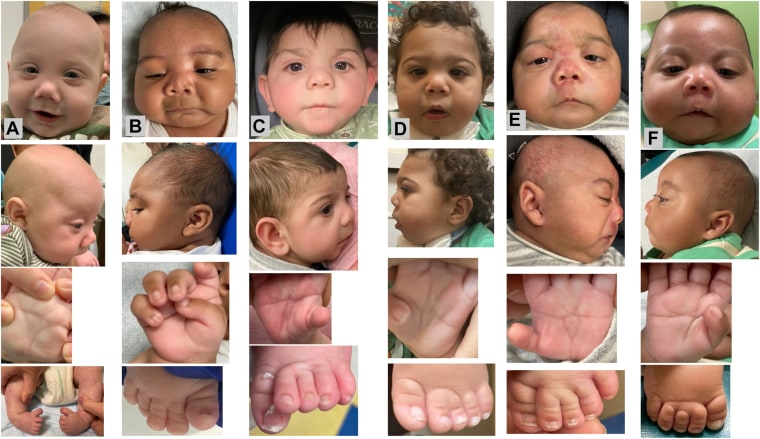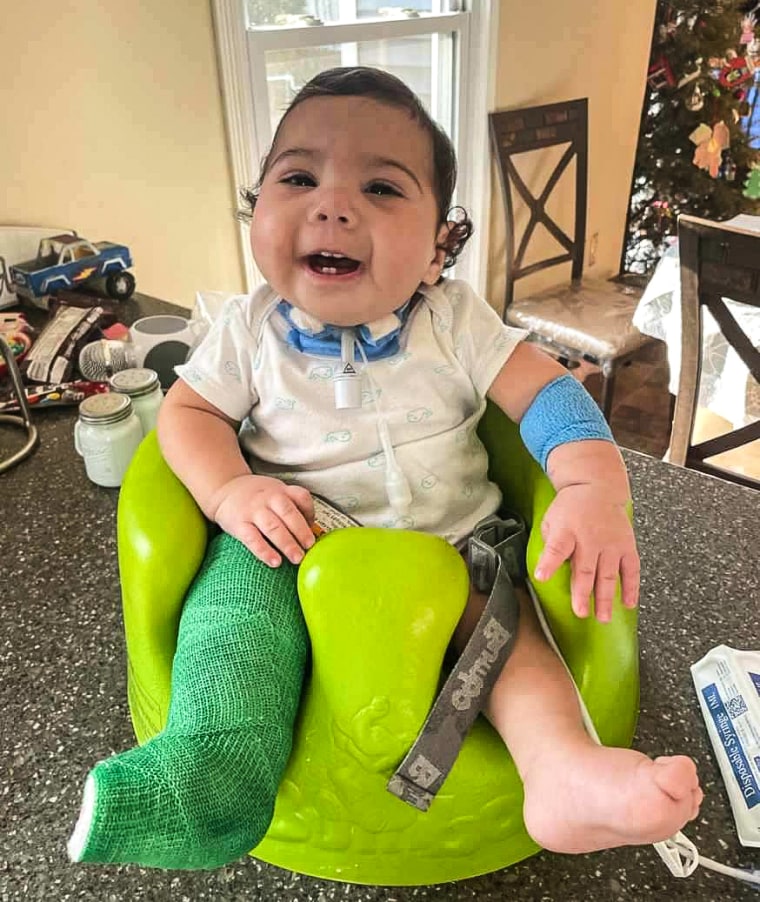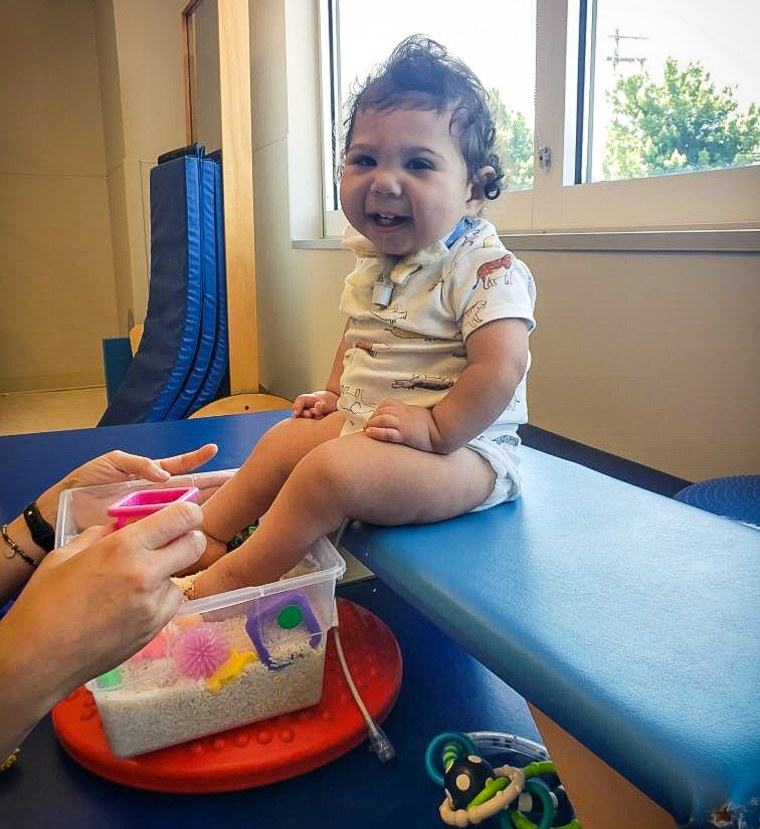At least 10 babies — possibly more than 12 — have been identified with what doctors believe to be a new syndrome related to exposure to fentanyl in the womb.
All of the infants have distinctive physical birth defects, such as cleft palate and unusually small heads. No common genetic cause has been uncovered — all were born to mothers who said they’d used street drugs, particularly fentanyl, while they were pregnant.
“This is concerning,” said Dr. Elizabeth Cherot, the president of the March of Dimes. “As we see these shared characteristics identified, we may be unroofing a real syndrome.” Cherot hasn’t personally cared for any of the babies.
Six babies were identified at Nemours Children’s Health in Wilmington, Delaware, two in California and one each in Massachusetts and Rhode Island. Erin Wadman, a genetic counselor at Nemours, and her colleagues published their findings recently in Genetics in Medicine Open.
The aha moment linking the infants came in August 2022, when Wadman was called upon to consult in the case of a baby who’d been born with birth defects.
“I was sitting there in the appointment, and I was just like this face looks so familiar. This story sounds so familiar. And I was just thinking about how this patient reminded me so much of a patient I’d seen earlier in the year and then other patients I’d seen,” Wadman said. “That’s when we were like we think we might have stumbled on something really big here.”

In addition to cleft palate, the 10 infants have unusually small bodies and heads. They tend to have drooping eyelids. Their noses tend to turn upward, and their lower jaws are often undersized. Their feet may point down and inward, and two of their middle toes are webbed. Baby boys may have genital irregularities. Some have trouble feeding, and their thumbs may not be fully formed. The physical similarities reminded Wadman and a Nemours colleague, Dr. Karen Gripp, a geneticist, of a syndrome called Smith-Lemli-Opitz. In those cases, genetic variants affect how fetuses process cholesterol, which is necessary for normal cell function and brain development.
None of the babies were found to have the Smith-Lemli-Opitz variant or any others that would put them at risk for such defects, however. Gripp, who is also a pediatrician, and Wadman suspect that fentanyl may be causing similar disruptions to cholesterol metabolism during pregnancy.
“Although fentanyl’s effect on cholesterol metabolism has not been directly tested, based on indirect evidence, it is biologically plausible that it affects cholesterol metabolism in the developing fetus,” the authors wrote in the new report.
The babies tested positive for fentanyl exposure when they were born, but the Nemours team suspect they had been exposed to significant amounts of the drug throughout the entire pregnancies.
Still, Wadman said much more work is needed to confirm the findings, “even to prove that it is, indeed, the fentanyl and not anything that’s laced in it or other drug that we’re missing.”
Possible causes
No proof yet links fentanyl to the cases, and in fact there are many possible causes. It could be that other street drugs or contaminants in the fentanyl supply are causing the defects. Even mosquito-borne diseases, such as Zika, have been known to lead to microcephaly (unusually small heads) if babies are exposed in utero, though there is no evidence Zika plays a role in the cases.
The women in the study were “also taking many drugs,” said Dr. Nora Volkow, the director of the National Institute on Drug Abuse. “It’s very hard to determine is this just the effect of fentanyl or is this really the effects of other drugs or other combination?”
“Having said that, reports like this one are very important, because they shed light on issues that we need to systematically investigate,” Volkow said.
Last year, NIDA launched a large research project called the Healthy Brain and Child Development Study aimed at following women and their children from pregnancy through age 10. “It’s a prospective study to evaluate consequences of drug exposures during pregnancy,” Volkow said.
The fentanyl-cholesterol theory may be proven — or not — through ongoing work at the University of Nebraska Medical Center in Omaha.
Dr. Karoly Mirnics, the director of UNMC’s Munroe-Meyer Institute, has dedicated research to studying the impact of a variety of drugs on cholesterol metabolism.
That is because cholesterol is “essential for everything in your body, for every cell membrane, for every function,” Mirnics said. “If there is no cholesterol, there is no life.”
Mirnics plans to study the blood of the babies identified at Nemours and elsewhere to answer looming questions:
- Is the underlying cause fentanyl or some kind of contamination of the drug?
- Does it depend on how much fentanyl gets to the fetus?
- Is the problem some kind of interaction between the drug and genetics of either the mother or the baby?
- Why would some babies exposed to fentanyl or other drugs during gestation develop defects while others don’t?
“I have no idea,” Mirnics said, “but I’m going to figure it out.”
More cases?
While fentanyl use has skyrocketed in recent years, even among pregnant women, there is no indication that birth defects are rising.
About 3% of babies are born every year with birth defects, according to the National Center for Birth Defects and Developmental Disabilities at the Centers for Disease Control and Prevention. The group declined to comment on the Nemours research.
“We haven’t seen this specific syndrome, but babies [exposed to fentanyl] are often born growth-restricted, smaller than they need to be,” said Dr. Brian Smith, the Samuel L. Katz distinguished professor of pediatrics at Duke University Medical Center in Durham, North Carolina. They are “profoundly irritable” and often don’t eat or sleep well, he said.
The new findings from Nemours have prompted other experts to take another look at babies who may have been similarly affected.
Dr. Howard Saal, a clinical geneticist at Cincinnati Children’s and the University of Cincinnati, believes he has seen two babies “fairly recently” with the same birth defects who were exposed to street drugs in utero.
“Their pattern of anomalies fits very closely with what has been described in this report,” Saal said. “I may have seen more cases in the past but didn’t put 2 and 2 together.”
And Dr. Ahmed Ahmed, a medical geneticist in the department of Maternal Fetal Medicine at the Cleveland Clinic, believes he, too, has seen cases. But complications related to drug use during pregnancy are “invisible,” he said. “There is no ultrasound or blood test that we can do to determine the impact an exposure may have had on the fetus.”
“We see similar anomalies, and we go the whole nine yards with diagnostic testing. But the results come back negative,” Ahmed said. “Deep down inside, you think that it is related to the substance abuse, the fentanyl or others, but you are unable to prove it.”
Ahmed said he and his team are amenable to sharing notes with the Nemours team to further the research. For now, he will use the information to counsel women, ideally before they become pregnant.
“I can use this paper to highlight that there is a potential risk for structure defects,” Ahmed said.
Dr. Sonja Rasmussen, a medical geneticist at Johns Hopkins School of Medicine in Baltimore, praised the “astute clinicians” at Nemours for first noticing what could be an important trend.
“That’s how fetal alcohol syndrome was recognized. That is how isotretinoin [the acne medication Accutane] that causes a distinct pattern of birth defects was recognized,” said Rasmussen, one of the first to describe the defects associated with Zika virus while she was at the CDC.
The best ‘yes’
Lindsay Carlisle, 40, of Washington Township, New Jersey, knew exactly what she was seeing when she first laid eyes on little Sammy in July 2021. He’d been born nearly two months earlier, addicted to opioids, and he had other medical problems. Carlisle had been called in as a possible foster parent, but she felt right away that Sammy would become her adoptive son.

“Initially, we never were on board with having a medically complex child, just because we didn’t think we could handle it. We weren’t really equipped,” Carlisle said. “But then I said ‘yes,’ and it was the best ‘yes’ I’ve ever said.”
Now 2 years old, Sammy requires large amounts of therapy. He faces several developmental and physical delays. His joints aren’t well-formed, Carlisle said, and he lacks hand strength. He isn’t yet talking, but he can make sounds. He depends on a feeding tube to eat. He has required a procedure to correct a heart defect.
His case is one of the 10 described in the Nemours report.
A public health crisis
If the syndrome is linked to in utero fentanyl use, it appears to be rare.
Dr. Stephen Patrick, a neonatologist and the director of the Vanderbilt Center for Child Health Policy in Nashville, Tennessee, said he has never treated such a patient. He has, however, cared for many babies born addicted to fentanyl and other drugs — all without the physical defects described in the new report.
That doesn’t mean fentanyl use during pregnancy, especially from drugs obtained illegally, is safe. It is associated with preterm birth, stillbirth and neonatal abstinence syndrome.
It’s clear, Patrick said, that substance abuse during pregnancy is dangerously common, having reached new highs during the coronavirus pandemic.
“Pregnant women are dying at record rates. Infants are the fastest-growing group entering foster care, mostly for parental substance use. The minority of pregnant women are getting into treatment,” Patrick said. “This is a big public health crisis.”
The path ahead
Researchers will continue to follow the babies over time. The oldest is now 3 years old. Further research may show that a subset of infants has some kind of underlying genetic risk that made them more susceptible to in utero fentanyl exposure.
The hope is to move genetics research forward.
“For most babies that are born with a birth defect, we don’t know the cause,” Rasmussen said. “Every time we can get a little bit closer to understanding what’s going on, it’s really helpful for families to understand their chances of this happening again in future pregnancies.”

Meanwhile, the newly identified syndrome means children like Sammy have unclear paths moving forward.
“We don’t really know exactly what this means for him, cognitively, because there is no one there to say, well, this is what happened and this is what they did,” Carlisle said. “We’re just kind of winging it.”
She hopes to meet other families in the Nemours research group. The Carlisles officially adopted Sammy in February.
“I promised him I would give him the very best life that anyone could ever want from the day I met him,” Carlisle said. “He’s just magical.”
Follow NBC HEALTH on Twitter & Facebook.






